Barcelona’s megamonument, La Sagrada Família, is a sight to behold. Gaudís unfinished masterpiece of a church has a lot to take in from its elaborate exterior to its symbolic interior. To make sure you don’t miss anything important as you weave through the crowds, here are the top things to see at Sagrada Família.
Pro Tip: Planning your visit to Sagrada Familia in Barcelona? Bookmark this post in your browser so you can easily find it when you’re in the city. See our Barcelona Guide for more planning resources, our top Sagrada Familia tours for a memorable trip, and the best restaurants near the Sagrada Familia.
Top 9 Things To See at Sagrada Familia
Gaudí became the Chief Architect and Director of Works of the Sagrada Familia in 1883. Today, well over 100 years have passed and the original artist is no longer with us, but construction moves forward.
The Sagrada Familia is a wonder of modern architecture that has few rivals. There are other structures, like St. Peter’s Basilica, that you could argue are more impressive but you’ll have to come and see for yourself. Sagrada Familia stands out as the greatest basilica and stone construction of the modern era.
The Sagrada Familia’s elaborate facades and breathtaking interior are more than deserving of an explanation by a local expert guide. You’re definitely going to want to hear about Gaudí’s inspiration and the symbolism behind both the exterior and interior. You’re sure to see it anew on a guided Sagrada Familia tour! Here are the top things to see at Sagrada Familia.
Not ready to book a tour? Check out how to visit the Sagrada Familia.
9. Jesus Presented to the Crowd by Pontus Pilate
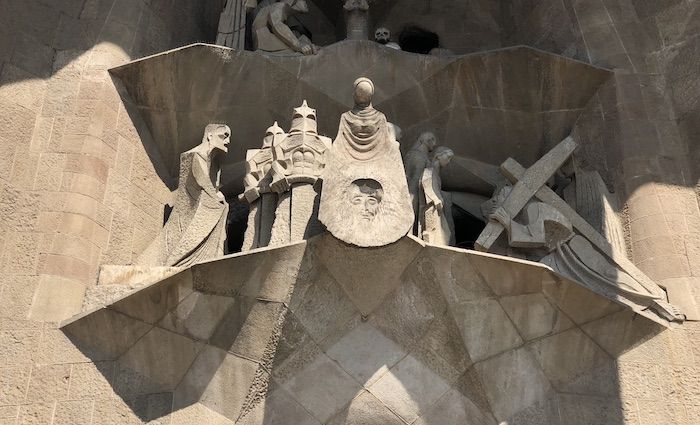
On the western side, the Facade of Passion, Josep Maria Subirachs carved around 100 figures, including Jesus being presented to the crowd by Pontus Pilate.
Jewish elders were frustrated with the prophet claiming to be the son of God and demanded his death. Pilate would have sought peace because the Romans didn’t care as much about the local religions in the provinces and focused more on control. Subirachs did an incredible job keeping in line with Gaudí’s design while implementing his own style.
8. The Nativity Facade (Eastern Side)
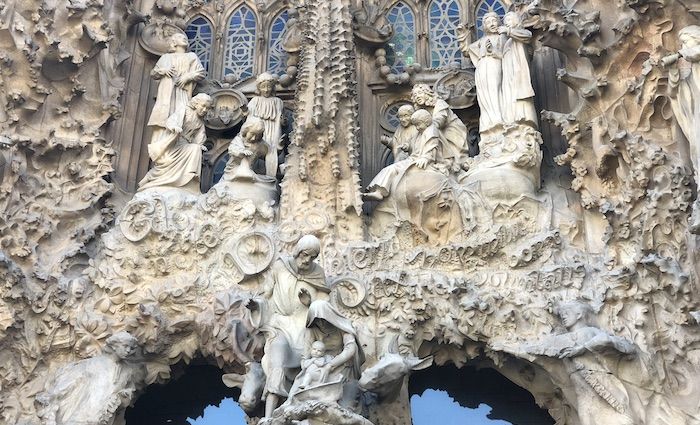
Also known as “the Birth of Christ”, this facade was completed first and contains a completely different stylistic feel from the rest of the church. There are three entrances, or portals, named “hope,” “mercy,” and “faith”.
The facade is intended to have a rough and almost confusing look. The idea is to play up the power and lack of understanding of God the creator as a being. If it is confusing to understand, it’s because we are not intended to understand.
There’s also more detail than only the birth of Christ as a human being. This facade includes animals and plants as part of the “birth” of God’s world as a whole creation. You’ll also notice that the angels are without wings—Gaudí believed they were unnecessary.
Popular Barcelona Tours
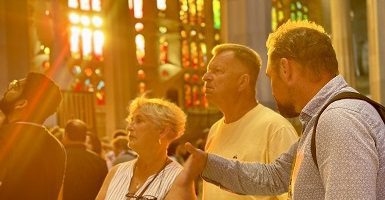
Best Selling Tour
Unbeatable Barcelona in a Day Tour
Our Barcelona in a Day tour covers all the major attractions plus hidden gems. This walking tour includes Sagrada Familia, Casa Batlló, Casa Mila, the Gothic quarter, Park Güell, and a coach ride to reach the more remote sites.
See Prices
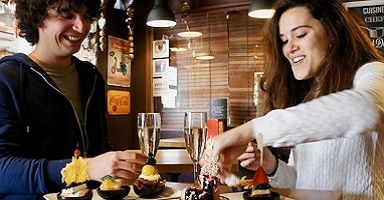
Customer Favorite
Barcelona Food & Wine Tour with a Local Sommelier
We can’t think of a better way to explore a city than to eat your way through it, and there will be enough tapas and wine to discover a lot of Barcelona! Join us on a delicious discovery of Poble Sec and Sant Antoni—some of Barcelona’s most vibrant foodie areas!
See Prices
Not ready to book a tour? Check out our best Barcelona tours to take and why.
7. Passion Facade (Western Side)
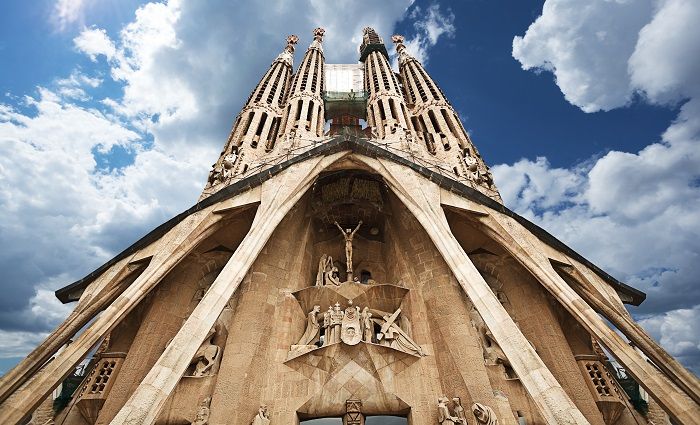
If you’ve read the Bible or gone to church, you know that the Passion of Christ refers to the period of suffering and up to his death. The very word “passion” comes from the Late Latin word meaning “suffering” or “enduring”. So, representations of the Passion of Christ usually display a crown of thorns and Jesus carrying the cross.
This facade has a very modern feel with clean lines on the structure. Gaudí and Josep Maria Subirachs, who sculpted many statues on this facade, integrated a lot of interesting details on this side. For example, the cryptogram is a four-by-four square with sixteen total numbers that add up to 33 on every side and a linear combination including diagonals.
6. The Facade of Bliss
The yet-to-be-completed Facade of Bliss is the last of the three facades. It represents the third evolution of Christ as well as a mark of the holy trinity (father, son, and holy spirit). The use of sets of three in Christian artwork is common. However, don’t let the name fool you as the Facade of Bliss features some less-than-blissful symbolism.
This third and final facade features the Last Judgement, Hell, and Heaven (eternal bliss). The Last Judgement is something we will all face according to Christian dogma and it won’t be pretty for anyone.
Prior to ascending to heaven, if you’re lucky, you’ll face some turbulent circumstances according to artists like Michelangelo who depicted this day fiercely in the Sistine Chapel. Next, you have hell and heaven, which are more straightforward. Expect this facade, like the others, to have a very unique design with matching geometric forms.
5. The 18 Towers
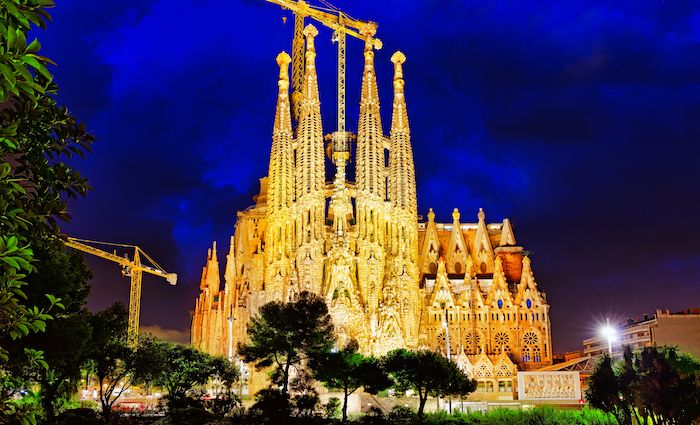
Currently, eight of the 18 towers or spires originally designed by Antonio Gaudí are completed. Four of the eight completed towers are on the Passion Facade and four are on the Nativity Facade. All eight completed spires are dedicated to eight of the 12 apostles. The remaining four towers will be seen on the third facade once completed.
The remaining six towers will be dedicated to Jesus, the Virgin Mary, and the four evangelists (Matthew, Mark, Luke, and John). All towers/spires are over 300 feet tall (91+ meters). The tower dedicated to the Virgin Mary will rise 404 feet (123 meters) off the ground.
Why didn’t he build more while still alive? Since he knew the building would take a lot longer, he decided to build vertically instead of horizontally. By focusing all his efforts on the Nativity Facade, he was able to see a completed bell tower free of scaffolding. This took place a few months before his death.
4. Illuminated Christ on Cross (Gloria A Deu, A Dalt Del Cel)
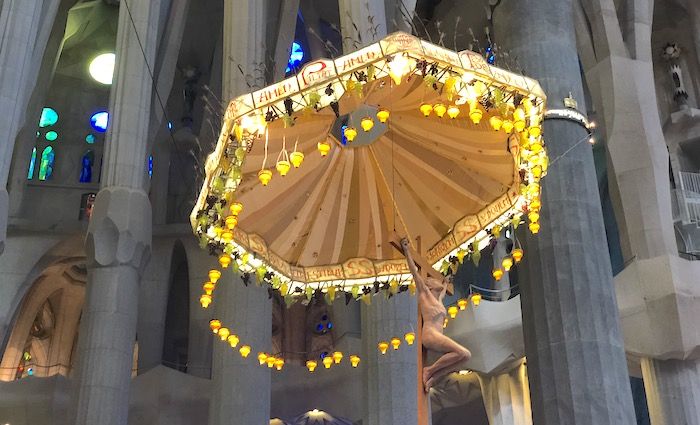
It’s hard to describe this feature without offending the extremely religious, so I’ll put it as lightly as possible. The feature in which christ is suspended would look more appropriate at a beach-side bar rather than suspended over the dramatic sculpture of Jesus on the cross, yet it feels right.
It has Spain’s cultural feel and, again, the extreme amounts of illumination inside the structure give the scene a more joyous feel. It’s a must-see element inside the church.
3. Stained Glass Windows
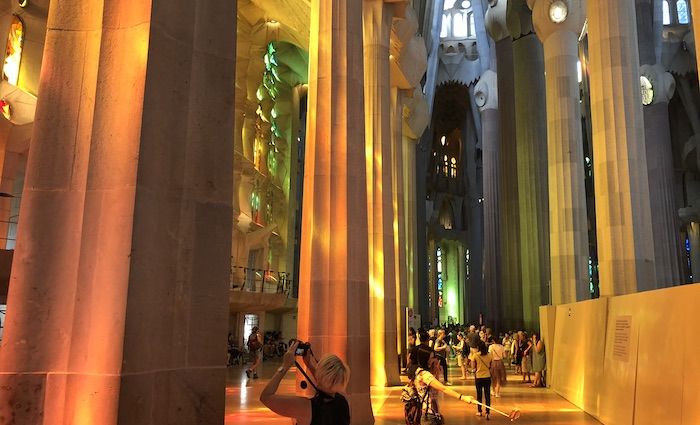
Like any large construction that spans centuries, Sagrada Familia’s design, construction, and conception will be credited to more than one person. The stained glass windows were created by Joan Vila-Grau.
Vila-Grau was born six years after Gaudí’s untimely death, which means he never had the chance to formally meet him. Even so, Vila-Grau understood his vision and was creative within the constraints Gaudí left.
In an interview with Margaret Martlew, Vila-Grau described that he worked within small descriptive phrases that summarized the artistic feeling one should get when observing. For example, one window was summed up simply by, “I am the water of life” and so he made that. Other guidelines were more rigid.
For example, Gaudí wanted the highest glass in white and the lower glass in color. This achieved two things. First, it would allow natural sunlight into the building and project itself upon the columns. Second, it would have been different than what was commonly practiced, which was very much Gaudí’s style.
One of the cool features to look out for when you’re inside is the effects of the stained glass windows on the interior light (see above), which is described to be more powerful than the windows themselves.
2. Buttresses and Flying Buttresses
Or should I say the lack thereof! When you think buttress or flying buttress, you should think Notre Dame. I don’t downplay the greatness of Notre Dame nor do I intend to do so. That said, Gaudi eliminated the practice altogether and his basilica stands! Well, the part that has been completed stands.
According to Sagrada Familia’s official website, Gaudí looked at these mechanical forms as crutches and not elevating or beautifying elements. So, he eliminated them giving Sagrada Familia the extremely unique baroque look and feel you see today, which may very well be the last great stone structure ever built.
Popular Barcelona Tours
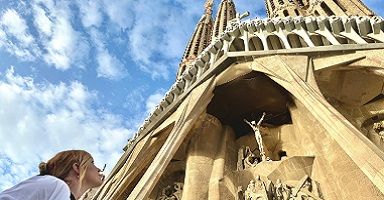
Best Selling Tour
Skip the Line Sagrada Familia Tour
Sagrada Familia is a three-sided gothic masterpiece designed by visionary Antonio Gaudí which has yet to be finished. The church is nearing completion and a wonderful display of color and architecture. Visit with a passionate local guide and skip the lines for admission!
See Prices

Customer Favorite
Barcelona Food & Wine Tour with Local Sommelier
We can’t think of a better way to explore a city than to eat your way through it, and there will be enough tapas and wine to discover a lot of Barcelona! Join us on a delicious discovery of the Gothic quarter – one of Barcelona’s most vibrant areas!
See Prices
Not ready to book a tour? Check out our Sagrada Família Guide for more resources.
1. Inside Nave/Vaul
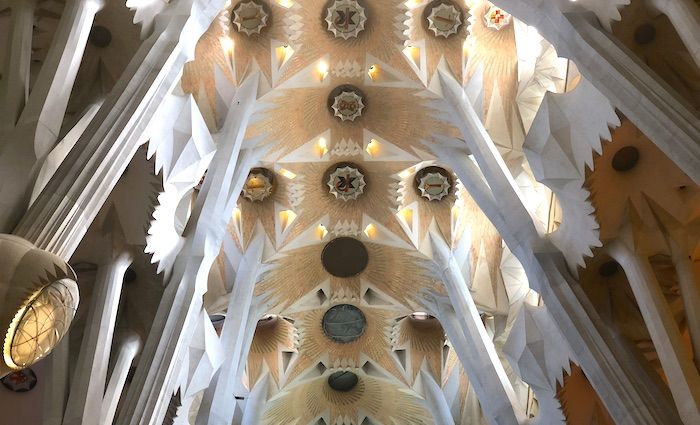
The central nave of Sagrada Familia is almost 150 feet tall (45 meters) and without argument the most eye-catching feature of the interior church. Much of the allure is that the ceiling appears to be floating.
This is mostly due to the thin columns that look like the branches of a tree. Notice that a few of these columns are split on the end, which gives the interior a very organic feeling as if it were alive.
Unlike the Renaissance churches of Italy, Sagrada Familia is bursting with bright colors much like the rest of Barcelona. It seems as though a renowned architect, sculptor, and Dr. Seuss all got together and built the exquisite interior of the church.
Sagrada Familia’s Completion Date
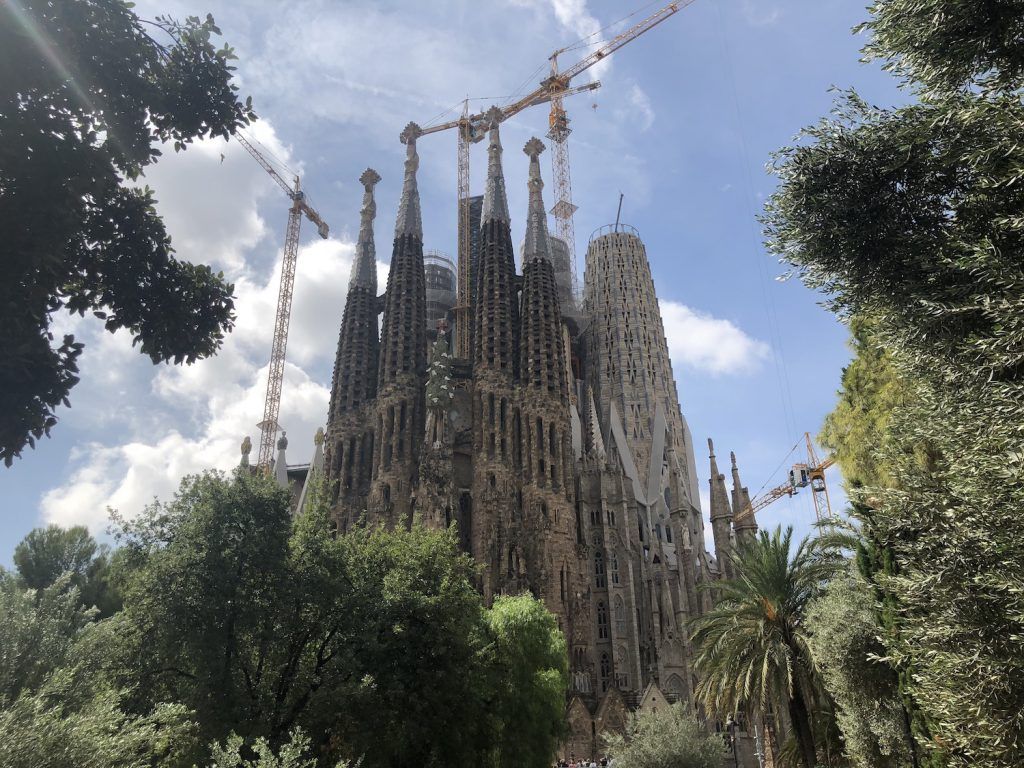
Ironically, the most visited building in Barcelona has been under construction without a legal permit from the municipality. After 134 years of construction, Sagrada Família recieved a legal construction permit in April of 2019.
Following this new agreement, the company leading the erection of Sagrada Família announced the beginning of the construction of the last five towers, which heralds the beginning of the end.
The year of completion of Sagrada Família has become almost a guessing game due to its monumental dimensions and complexities. I once read 2022, but later read 2025. It seems likely construction will end before 2030, which puts it in the same league as St. Peter’s Basilica in terms of construction time.
Not ready to book a tour? Check out our Sagrada Família Guide for more resources.
Tickets and Opening Hours
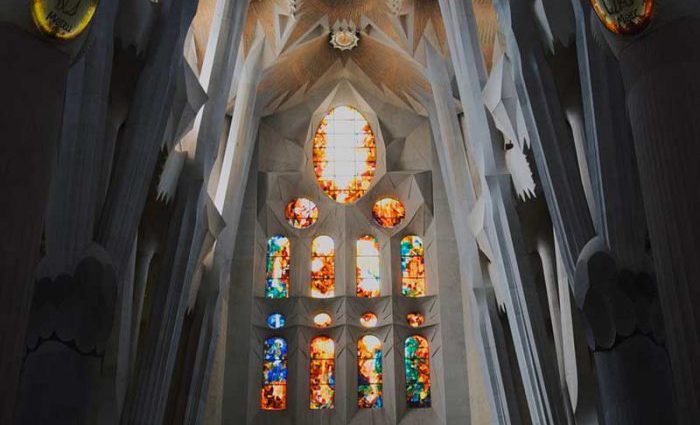
Here’s some basic information about tickets, opening hours, and where to find the Sagrada Familia. For a more comprehensive guide on the best ways to see this megamonument, see how to visit Sagrada Familia.
Admission Cost: €20
Visiting Hours: November to February: Mon – Sun, 9 am – 6 pm; March and October: Mon – Sun, 9 am – 7pm; April to September: Mon – Sun, 9 am – 8 pm; 25th and 26th Dec, Jan 1st and 6th: 9 am – 2 pm.
Address: Carrer de Mallorca 401
Not ready to book a tour? See the best Barcelona tours to take and why.

Where To Stay in Barcelona
A great hotel at a great price has become the norm in this internet era. Our article explains what areas are the best in Barcelona so you can get a great deal on the perfect location!
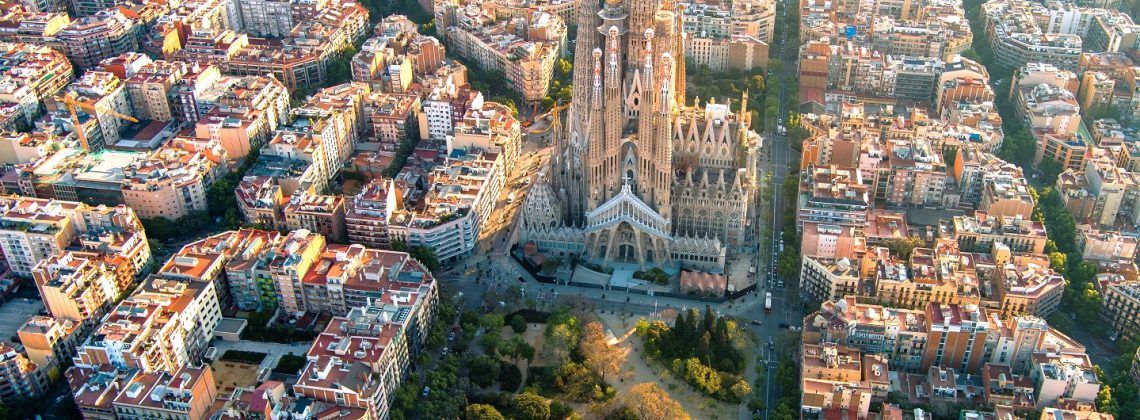
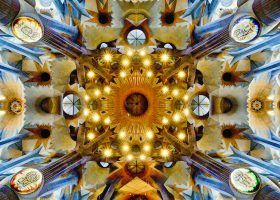
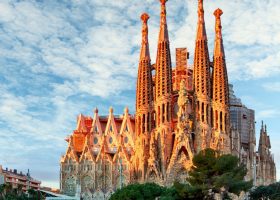
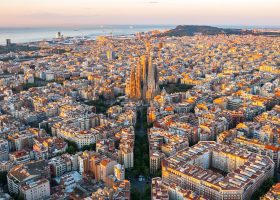


In May it was our third visit to Antoni Gaudi’s fabulous La Sagrada Familia and yet again we were in awe!
The detail in this cathedral is mind blowing… from a distance, it looks very Gothic in nature but then you get closer and every single element leaves your jaw hanging. From the lighting, the tree-like columns, the sculpture… It’s safe to say we have witnessed a work of art in the making!
They’re aiming to finish construction by June 2026 – this will coincide with the 100th anniversary of Gaudí’s death.